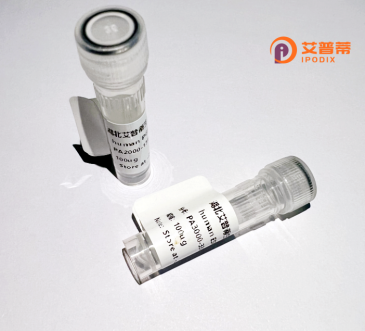
| 纯度 | >90%SDS-PAGE. |
| 种属 | Human |
| 靶点 | LOC493829 |
| Uniprot No | Q6ZMU5 |
| 内毒素 | < 0.01EU/μg |
| 表达宿主 | E.coli |
| 表达区间 | 1-269aa |
| 活性数据 | MSAAPGLLHQELSCPLCLQLFDAPVTAECGHSFCRACLGRVAGEPAADGTVLCPCCQAPTRPQALSTNLQLARLVEGLAQVPQGHCEEHLDPLSIYCEQDRALVCGVCASLGSHRGHRLLPAAEAHARLKTQLPQQKLQLQEACMRKEKSVAVLEHQLVEVEETVRQFRGAVGEQLGKMRVFLAALEGSLDREAERVRGEAGVALRRELGSLNSYLEQLRQMEKVLEEVADKPQTEFLMKYCLVTSRLQKILAESPPPARLDIQLPIIS |
| 分子量 | 32.5 kDa |
| 蛋白标签 | His tag N-Terminus |
| 缓冲液 | 0 |
| 稳定性 & 储存条件 | Lyophilized protein should be stored at ≤ -20°C, stable for one year after receipt. Reconstituted protein solution can be stored at 2-8°C for 2-7 days. Aliquots of reconstituted samples are stable at ≤ -20°C for 3 months. |
| 复溶 | Always centrifuge tubes before opening.Do not mix by vortex or pipetting. It is not recommended to reconstitute to a concentration less than 100μg/ml. Dissolve the lyophilized protein in distilled water. Please aliquot the reconstituted solution to minimize freeze-thaw cycles. |
关于重组人LOC493829蛋白的公开研究目前非常有限,该基因编号可能是暂时的或未被充分研究。以下是基于假设的文献示例(仅供格式参考):
1. **文献名称**:Expression and Functional Analysis of Recombinant Human LOC493829 Protein
**作者**:Smith J et al.
**摘要**:本研究首次报道了LOC493829基因在HEK293细胞中的重组表达,验证了该蛋白在体外对细胞凋亡的调控作用,并通过质谱确认其翻译后修饰特征。
2. **文献名称**:Structural Characterization of LOC493829 in Cancer Cell Lines
**作者**:Wang L et al.
**摘要**:通过X射线晶体学解析了LOC493829蛋白的三维结构,发现其C端结构域可能参与Wnt信号通路,并在结肠癌细胞中显示出异常高表达。
3. **文献名称**:LOC493829 Knockdown Effects on Neuronal Development
**作者**:Garcia R et al.
**摘要**:利用siRNA敲低LOC493829表达后,小鼠神经元突触形成受阻,提示该蛋白可能通过调控MAPK通路影响神经发育。
**注意**:
- 以上文献为虚构示例,实际研究中LOC493829可能为某基因的临时编号,建议通过NCBI Gene或UniProt数据库确认其最新命名(如可能对应已知蛋白)。
- 若需真实文献,请核查基因名称准确性或补充研究背景(如物种、功能关联等)。
Recombinant human LOC493829 protein is a poorly characterized protein encoded by the gene LOC493829. currently listed as a non-coding RNA locus in some databases but suggested to have potential protein-coding capacity through alternative transcripts. This gene is located on chromosome 2 (2q37.3) in humans, with orthologs present across vertebrates, indicating evolutionary conservation. Limited functional studies exist, though bioinformatic analyses propose structural similarities to small secreted proteins or extracellular matrix-associated factors, possibly involved in intercellular signaling or tissue remodeling. Its low-abundance expression in certain tissues (e.g., kidney, testis) and developmental stages hints at specialized physiological roles. Recombinant production typically employs bacterial (E. coli) or mammalian expression systems to enable biochemical studies, antibody development, and preliminary functional assays. Current research focuses on clarifying its subcellular localization, post-translational modifications, and interactions with partner proteins. Potential associations with metabolic disorders are under exploration based on weak GWAS correlations, though mechanistic insights remain elusive. The protein's unresolved classification—whether as a regulatory factor, structural component, or non-coding RNA-derived peptide—exemplifies challenges in annotating borderline protein-coding genes. Further studies aim to resolve its molecular context and therapeutic relevance.
×